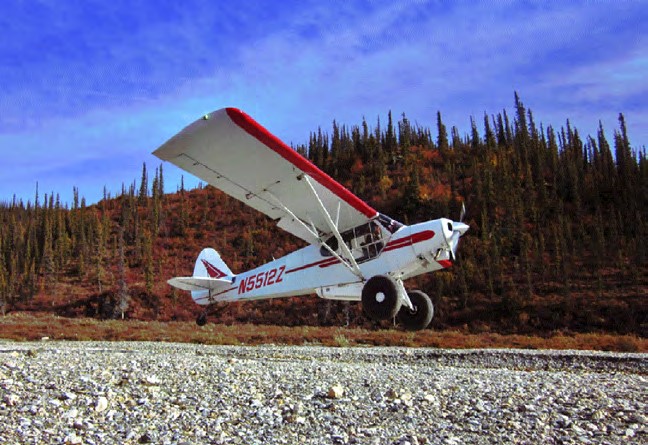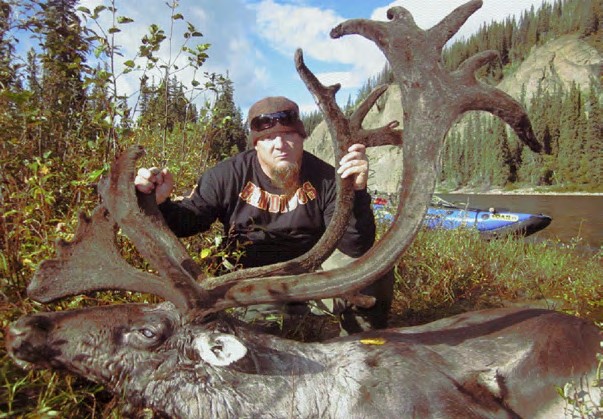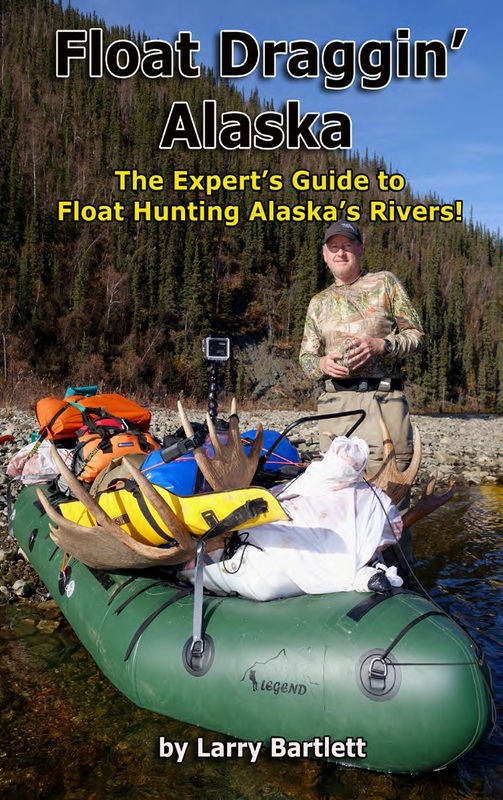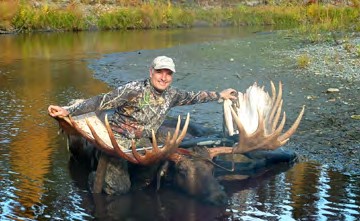My reputation as a Hunt Planner depends on my ability to plan like a professional, since each season many groups entrust me to remove the burden and unknowns of reaching Alaska and securing a float plane that sees them into the bush and back again with their goals realized. If something goes wrong on their hunt, it should not be a result of poor planning on my part. I’ve put together the details that serve me well when executing a plan that provides a reliable platform for other hunters to succeed. When building a DIY hunt plan for Alaska, the foundation is a solid plan. Here’s how to plan like a pro!
Hunting Regulations
Every group should have a copy of the Alaska State Hunting Regulations booklet with them in the field, secured inside a large Ziploc storage bag. You’ll want to keep the pages dry and readable because they are printed on flimsy paper, and because they provide excellent tinder when you need a quick fire. But most importantly, you want them to remain readable because it is unequivocally an individual responsibility to abide by state and federal laws when hunting in Alaska. Each GMU (Game Management Unit) has unique and game-specific laws for hunting and tagging a harvested animal, and some also have specific salvage rules (on-the-bone requirements). Read them often afield, and ensure all measures are taken to avoid game violations. You simply never know when a wildlife conservation officer or State Trooper will drop by for a camp visit. Make sure to obtain a current booklet, since adjustments to bag limits and hunt seasons occasionally occur after regulations are printed.
When and Where To Hunt
Deciding when and where to hunt in Alaska is a daunting task. You must first decide your personal and group travel windows or restrictions. Does your job demand your return home before some Units open or close? Can you a lot time to hunt throughout the month of September, or only starting after the 10th for some reason or another? Such questions must be answered by all group members and decided collectively as a team, well before the specifics of your trip can be arranged.
For moose hunting, the basic decision is whether to hunt early or late season. Most GMUs have season windows starting between September 1-5, extending to September 15-25. If you know which GMU you want to hunt, the timelines are clearly printed in the Hunt- ing Regulations.
Which river to pursue within a Unit will be decided by how remote you wish to be and the specific river character that matches your skill level. To dial in the best spot takes a lot of research and phone calls to key professionals who either fly the area or who have personal experience on specific rivers in that region.
The question then remains, early or late season? That might be decided once you narrow down the where-to specifics. For example, if you decided that GMU 20E is your target for moose hunting, then the season dates run from September 8-17 for residents and non-residents but offers an early season hunt for residents only from August 24-28. If you opt for GMU 25A, then season dates run September 5-25 for both residents and non-residents. For these reasons, many hunters rely on successful friends to suggest an area to focus, and then decide when the best time might be to plan a hunt.
Most GMUs have liberal hunt dates for caribou, starting in July and remaining open until the following spring. Caribou hunters must first decide whether they want to hunt during August or September, and then determine whether they wish to harvest bulls with velvet or hard horns stripped of velvet. On average throughout Alaska, caribou bulls shed velvet starting the third week of August. Moreover, hunters must then decide how close to rut (October) they are willing to pursue caribou for meat quality purposes, coupled by weather threats in late season that tempt freezing river conditions.
Some great sources for determining where or when to hunt are pilots who frequent certain areas, land managers, game-specific biologists, and internet sources like forums, blogs and chat rooms. By asking a lot of questions about game densities and the best times of year to hunt those animals, hunters can gather a network of usable information to help them narrow down the right spot and best time of year.
Determine Your Budget
How much can we expect to pay per person from door to door for our Alaska hunt? This is the single most common question I’m asked as a Hunt Planner. The answer is always the same—a lot less than a guided hunt and more than it cost 15 years ago.
Expect average moose hunts and some combo moose/caribou hunts to range from $3,000 to $5,000 per person, which includes raft rental fees and bush logistics only. Some hunts are less expensive if less bush travel is required, such as with road accessible river options or areas closer to hubs like Fairbanks, Anchorage, Delta Junction, or Tok. The exact amount will depend on which GMU you decide to hunt,
Additional costs for food, lodging, rental cars, commercial airfare, last minute gear, and shipping meat and antlers back home currently range between $1,000 and $1,500 per person. These prices are estimated costs for 2014, which are 25-30% higher than costs in 1999. However, some air charter companies have increased their prices as much as 45% since 2000. It’s important to shop around to find the best service for the lowest possible cost.
What is driving this upward trend in hunt costs? Supply and demand coupled with rising fuel prices and general costs of doing business in remote Alaska.
DIY Hunts vs Guided

Guided or unguided will depend on your personal skill level, physical limitations, budget, and adventure quest. The average success rate for guided moose hunters is generally better than 50%, while the average success rate across Alaska for a self-guided moose hunt is 25-30%. If your goal is to harvest a nice bull with greater odds than returning home without bloodstains on your waders, then consider a guided hunt. But if your taste for self-reliance and striving outweighs your need to guarantee a kill shot, then do it on your own. The lasting memory will be of greater value, and the experience of hunting with trusted friends will enrich your life.
Develop Expectations
Many of the hunters who contact me for Hunt Planning have already developed initial expectations based largely on TV hunting shows, magazine articles, online blogs, or from successful friends or relatives who have hunted Alaska. The majority of these hunters come to the planning table with inflated expectations of seeing “plenty” of moose over 50 inches and hope to see numerous bulls with 60 inch spreads and massive tines. Caribou hunters always expect to see streaming herds of shooter bulls within sling shot range of the river or campsites. I always hate to burst their bubbles, but it’s my job to give them straight answers in line with helping them develop realistic expectations about Alaska hunting.
The truth about moose hunting in Alaska is there aren’t bulls behind every willow bush. Float hunters will be lucky to see a small handful of bulls on any given 10-12 day hunt. Even less common are those bulls with antler spreads greater than 60 inches. The average antler width our hunters have harvested in the past 15 years has been consistently smaller than 60 inches, and only three bulls in 15 years have measured over 70 inches (< 1%). The average size antler spread for moose harvested in Alaska is 54 inches. Our records indicate that only 15% of the total number of bulls our clients shoot have an antler spread greater than 60 inches, and roughly 4% have been bulls with at least 4 brow-tines on one side and antler widths of 45-49 inches. That leaves 80% probability of harvesting a moose with antler widths between 50-59 inches. Furthermore, bull moose sightings on all float trips generally average fewer than six.

It’s important to mention that caribou herds are notorious for their cyclic ebbs and flows with total populations. Die-offs and emigration and integration with neighboring herds are common with caribou. They are the most nomadic large mammal in North America, so expect nothing but the thrill of the chase when hunting caribou. Before heading afield, contact the area ADF&G biologist for the herd within the range you expect to float, and ask them about current herd status and likely expectations for encountering that herd. Be happy with a unique antler set, and be ready at all times to harvest your next bull. Caribou frequently come and go like grains of sand blown across the desert.
River Selection
Before selecting a river, each hunter must answer these down and dirty dozen:
What is your skill level and river experience?
Hunters who have never rafted before or who have limited river skills should not pursue river options with any great challenges or whitewater ratings. Many rivers suitable for hunting range from Class I to Class II, which are ideal for beginner to intermediate boaters. Many Class I streams have easy routes and defined channels with mild to moderate threats, like low water and sweepers. Class II routes are a bit more challenging but are still easy for intermediate boaters to negotiate. Keep in mind that once a raft is loaded with people, gear, and meat, maneuvers are sluggish and oar commands are less responsive. I highly advise that boaters rate themselves at least a Class lower than their known abilities when floating a full load. Heavily loaded rafts are simply more difficult to control and even mild river character becomes more threatening in these scenarios.
What kind of river character are you prepared to negotiate?
If a hunter has experience rafting or reading and negotiating rivers with challenging “character,” he still might be surprised when negotiating low water or fast Class II with obstacles such as boulders, tight corners, sweepers, strainers, etc. This becomes especially true when the raft is loaded with hundreds of extra pounds of meat and antlers. It’s important for hunters to admit what they can handle and try to match that experience to river character that can be safely negotiated. Try not to allow your goal of being isolated control your better judgment with river selection. A novice rafter with Class I-II skill level will be gravely challenged in most low water scenarios, when dragging hundreds of pounds becomes the only option to get through a boulder garden with little to no water. Try to imagine the worst possible river scenario within your skill level before selecting your hunting location.
What type of experience are you hoping to find?
Envision the whole experience you’re hoping to realize in Alaska. Decide whether remoteness is part of that vision and whether you have the skill and determination to overcome physical challenges that exist in remote settings. If your goal is to experience the thrill of an exciting hunting pursuit with less emphasis on river rafting or dragging threats, then stick to rivers with known suitability, and adjust your expectations to include encounters with other hunters. But, if you are up for a physical challenge in order to escape hunting competition and to secure total isolation, then you might search off the grid.
What are your harvest goals?
This question is important to weigh against statistical harvest success rates. Since the average success rate for moose hunters in Alaska is roughly 25%, discuss this reality amongst your group members to pare down the number of committed hunters. Historically, groups of two hunters can expect an average success rate of 50% if all goes well, while groups of four hunters can expect to shoot one or two moose if everything goes perfectly. Also, respect the fact that some remote river locales are not suitable for groups of four people, simply because of the physical reality of transporting more than one or two moose out of challenging scenarios or because of low moose populations. If you want to hunt a remote river or creek, expect that your group might need to use multiple rafts to effectively divide the load and maximize watercraft performance (flotation or draft). Is it possible for groups of two hunters to achieve 100% success? Of course, but it will depend on hunter skills, dedication, perseverance, and a tactical approach with raft selection—regardless of river selection. Is it possible for groups of four hunters to harvest four moose? Yes, but rarely—regardless of the factors above.
How many days will you have to float and hunt?
The average hunt timeline extends 10 days in the field, which leaves 8 days of actual hunting and floating. It is illegal to hunt the first day of the trip if accessed by aircraft, and the last day is typically spent getting your group back to civilization. So, is 8 days enough time to effectively hunt and also allow time to cover the necessary miles from the drop-off to the take-out? It may not be for your group. Many rivers vary in length and difficulty, so it’s important to estimate how much time you will need to effectively hunt and how many floating hours it will take to reach your take-out from the drop-off.
How long of a float do you desire, coupled with days of actually hunting? Some rivers have limited access points, which dictate the required distance. Many of these rivers are greater than 75 miles and up to 125 miles in some cases. A rough estimate to gauge the average river speed on rivers at normal stage is 2-3 mph on the drift, so the required float time for the distances just mentioned would be as many as 25-37 hours and 41-62 hours, respectively. The average raft day (time on the drift) is 5 hours, so that suggests that the number of days spent floating and not hunting would be roughly 5-7 days and 8-12 days, respectively. That further suggests that longer trip lengths require more hours each day on the water to allow adequate hunting days in between, especially if you only allow yourself 10 days in the field. On river floats longer than 100 miles, expect to spend 7-9 hours actively rowing on float days, which is an arduously exhausting day when weather, wind, and river character are unfavorable. That also means that longer trip lengths simply require more time in the fi ld to effectively hunt, so expect these journeys to require 12-14 days. While some bulls are taken on-the-drift, more animals are harvested from stationary camps and spotting perches. This suggests more hours should be spent on hunting rather than floating to find game animals.
What physical challenges suit your expectations and abilities?
Try to imagine what you want to experience on your float hunt. Some hunters are eager for the physical challenge of remoteness, others simply aren’t. Contemplate situations like mosquitoes, cold weather, known portages, terrible campsites, muddy or high riverbanks, etc. Remember that your group is only as strong as the weakest member on the team. It does no good for group dynamics when strong and eager members are paired with physically incapable teammates. Collectively discuss your individual goals and expectations before choosing a partner, which must precede your river selection.
What is your ideal float hunting setting?
Each hunter must be able to visualize what their ideal river hunting scenario might look like. Some hunters dream of alpine hillsides overlooking sparse spruce and willow stands near tree line (favorable to early season bulls), while others seek the traditional low-lying habitat amidst bogs, oxbows and boreal river habitat (favorable areas to moose during rut). Try to imagine how you’ll scout and pursue moose or caribou, and describe these scenarios to your partners to better flesh out your combined goals and expectations. Does everyone on the team want to be remote and are they willing to accept the low water threats in these places? Try to find a river with habitat that is suitable for everyone. Undoubtedly, compromises will be required to select your river destination.

Through his company, Pristine Ventures, Larry and his team support the growing interest in Do-It-Yourself Alaska Adventure, where their experience and strengths lie in planning remote operations for river travel, hunting, and serious wilderness adventure. They offer products, resources, and professional services that support these types of endeavors and are available to improve the quality of your Alaska adventures for big game hunting, wilderness exploration, and river travel.



